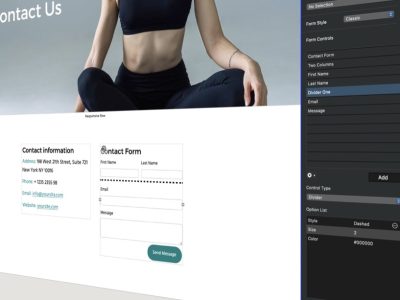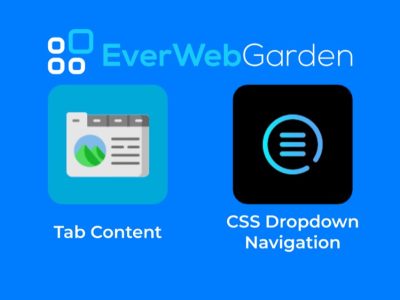EverWeb’s Assets Tab in the Inspector Window is where image files and other media in your website project can be accessed and managed. Getting to know what’s available in the Assets Tab has many advantages when using image files and media in your web pages. Here’s our guide to getting the best out of your Projects Assets.
What Is An Asset?
An EverWeb asset can be either an image file or other form of media such as an audio file, video clip, PDF file, ZIP file and so on. When you click on the Assets Tab you’ill notice two drop downs: one for ‘Images’ and one for ‘External Files’. You can expand or collapse these drop downs using the triangle to the right of the word ‘Image’ and ‘External File’.
Image Files and External Files
When you drag and drop an object on to the Editor Window, EverWeb automatically adds it to the Assets List in the Assets Tab. Images files are listed in the ‘Images’ section and all other types of media are listed in the ‘External Files’ section. If the file you are dragging and dropping on to your page is large, EverWeb will warn you first before adding it in to the page. Large files slow page load times and so are best avoided if at all possible in your website.
Images as External Files
If you’re adding a large image file to the Editor Window, EverWeb will warn you that the file is large and give you the option to import the image at ‘web resolution'(recommended), ‘high resolution’ which will load slower (not recommended) or as an ‘External File’. If you choose ‘External File’, the file can be made available in your page for download by hyperlinking to the file through e.g. a piece of hyperlinked text or button.
Adding Assets To the Assets List
Dragging and dropping an image or media file on to your page from its source location automatically adds it the Assets List. Alternatively you can drag an drop files directly on to the Assets List itself if you don’t want to use the file immediately, but want it available at a future date. Assets can also be added to the Assets List when you are adding files in to a widget e.g. using the Audio or Image Gallery widget.
Assets are Reusable!
One of the great things about assets is that they’re reusable! Once you’ve added a file to the Assets List, it’s available for use on on any page in your website project. Just drag and drop the asset from the Assets List on to the page you need it on. This saves time and effort and is good for managing the files in your project. You don’t need to reimport the same file multiple times if you need to use if more than once in your project. It also keeps the size of your project file down so that it does not slow down when you’re working on it.
Assets and SEO
Assets also have a role to play in your website’s SEO. Assets should always be named appropriately so they’re more easily crawled by search engine spiders. For example, if you have a photo of a rose in a garden that you’re importing in to your project from your camera, the image file may be called something like ‘DSC0000001’. It’s not descriptive of what the photo actually is so renaming the file as ‘Red Rose in Garden’ is better. It’s also easier for you to find the file again if you need to and it’s better for your SEO.
When renaming files for SEO purposes, it’s best to do so before importing it in to EverWeb as you gain the most benefit in SEO terms. If you have already imported the file in to your project, you can still rename it. Double click on the file name in the Assets List and enter the new, descriptive, name. Press Enter to finish. Whilst not as efficient as renaming prior to adding the file to your Assets List, it’s still better than not doing so at all.
Asset Administration
Set the options for viewing the Assets List by the up/down arrows to the right of the word ‘Assets’ just below the search box. The drop down list will give you options to sort assets by name, file size, date added and custom sort order.
Use the same menu to display detailed information about the asset itself such as file size, date added file type, set dimensions and resolution.
To remove assets that you no longer use in your project, again click on the up/down arrows opposite the word ‘Assets’. Select ‘Find Unused Assets’ from the menu. EverWeb will then search for unused assets and highlight them when finished. To delete the unused assets select ‘Yes’. Select ‘No’ to keep the assets highlighted so you can review what to keep and what not to keep.
Asset List Tips!
If you want to delete an asset at any time, click on it to select it then press the backspace key. You’ll be asked to confirm the deletion.
If you want to find which pages use a particular asset, select the asset in question then secondary click on it. From the submenu, select ‘Find Pages Using Asset’. Any pages using the selected asset will be highlighted in yellow in the Web Page List. To remove the highlighter secondary click on one of the highlighted pages in the Web Page List and select ‘Clear Using Assets Indicator’.
You can select multiple assets at once in the Assets List by selecting the first asset then holding down the shift key and clicking on the last asset you want to select. If you have assets that you want to select that are not listed next to each other, select the first asset then hold down the Command key and click on the next asset you want. Continue in this way until all assets you want have been selected. You can then e.g. delete the assets, drag the assets on to the page etc. all at one time.
Getting to know how to work with and manage assets in EverWeb will help you work more efficiently, will keep your project file streamlined and organised and will save you time and effort as you work towards completing your website!









Comments